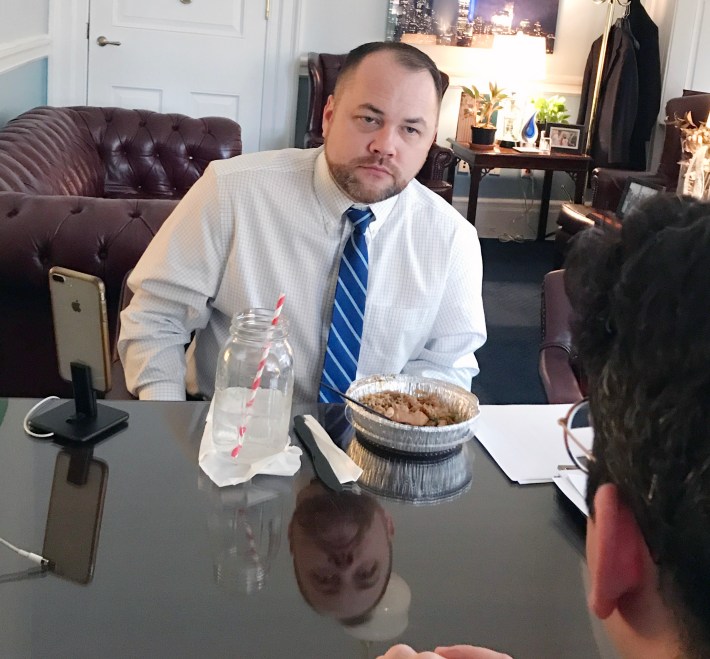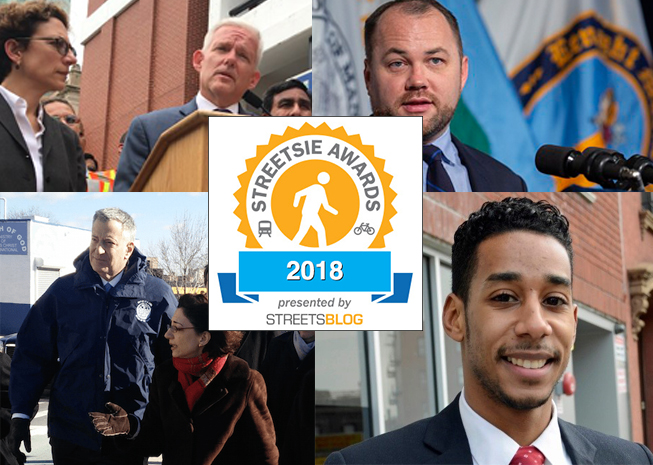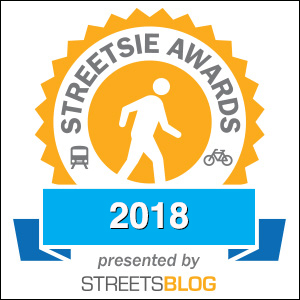Four words: Break the car culture.
Council Speaker Corey Johnson said those words in response to a question from Streetsblog's David Meyer earlier this month, and a year's worth of exceptional work on street safety issues came into full focus: When speed cameras went dark, Johnson harnessed the full power of his office and figured out a way to get them back on. When Albany slowed down on congestion pricing, Johnson put it back into the headlines by saying the Council might put up their tolls themselves. When the mayor worried that e-scooters represented an existential threat to New York, Johnson brought the topic back to reality.
More important, perhaps, Johnson has unshackled the talented members of his conference and allowed them to hold real committee hearings that hold the executive branch accountable. Both Transportation Committee Chairman Ydanis Rodriguez and Sanitation Committee Chairman Antonio Reynoso have emerged as genuine leaders on their respective issues.
But Johnson didn't easily walk off with the coveted Streetsie. There was some serious competition for Vision Zero Hero this year, including:
- The Department of Transportation: Streetsblog has covered the agency critically, but no other arm of city government values safety as seriously as the people at 55 Water Street and all the outlying offices. They are the reason that 2018 is on pace to be the safest year on record for pedestrians and cyclists.
- Mayor de Blasio: Hizzoner might have walked off with this award simply for building a pair of protected bike lanes over the objection of a group of pro-parking community cranks in Sunnyside, but he also backed his DOT in many important street safety redesigns all year long. Since taking office in 2014, de Blasio's belief in Vision Zero has saved scores of lives.
- The aforementioned Reynoso earned his nomination for his work in holding the rogue private carting industry accountable. He has also been out front in making sure his Bushwick district isn't forgotten during the L-train shutdown, which begins in April.
- Council Member Jimmy Van Bramer: After a cyclist was killed on 43rd Avenue in his Queens district, Van Bramer demanded that the DOT build a protected bike lane there. Now, we all know what happened next: Van Bramer did a disappearing act when the local community board and his power-broker patron Joe Crowley opposed the plan, going into hiding rather than disappointing local drivers, whose support he will need to run for Borough President. But, in the end, he did something no politician ever does: He admitted he was wrong, and has since become a great cheerleader for street safety improvements.
But the winner is Johnson.
Days before his win was announced, Streetsblog's David Meyer and Gersh Kuntzman grilled the speaker in his City Hall office, where he talked about adding more protected bike lanes, asserting the Council's authority, how to characterize an attack on cyclists in Queens, and, yes, breaking the car culture.

Here is the transcript, edited only for clarity and coherence:
Gersh Kuntzman: We have to start with four words, "Break. The. Car. Culture." You said it, so how are you going to do it?
Corey Johnson: I don't think there is a panacea or a silver bullet or one or two or three things. You need a really robust, thoughtful transportation agenda that invests a lot of resources and disincentivizes the use of cars and trucks and vehicles in New York City. 1. We need full bore congestion pricing, not as revenue generation, but as a way to decrease cars from coming into Manhattan — though breaking the car culture is not just about Manhattan, it's about the entire city as well. So you need better street design, more bike lanes, a real plan to crack down on placard abuse, which we're working on, you need to invest in bus rapid transit, dedicated bus lanes in more places, greater pedestrianization and plazas. And none of this is good unless you have real dedicated enforcement. Real enforcement. You can't have these illegal tractor-trailer trucks knowing they can come in and nothing is going to happen to them.
So breaking the car culture is about a really focused on pedestrians and cyclists and mass transit in a way that people feel like they can walk and bike and take the buses and subways in a way that feels safe for them, and it will be convenient for them and it will be fast for them — and right now, that's not the case.
GK: On congestion pricing, you said in September that the Council could do it without the state. Where are we?
CJ: It's very complicated. I do think there could be an opportunity to do some things on congestion pricing if Albany doesn't move. I am more hopeful now with the Democrats controlling the State Senate and progressives elected to replace IDC members. ... I feel a renewed sense of hope that we can get a full congestion pricing plan done. ... We are ready to do something, though what we can do is not nearly as good or as full as what the state could do.
GK: Some of your members oppose congestion pricing. They argue that it's a tax on the outer boroughs, etc.
CJ: There are a subset of members who are opposed to congestion pricing, but if you talked about ways to address the issues like transit deserts and increasing service for mass transit, whether it be improving the MTA and the buses. One of the things that helps is the Freedom Pass for LIRR to make fares affordable. So there are creative ways to address areas that don't have the transit infrastructure they need. We need to make transit easier so people will feel like they don't need their cars.
But you said it right, Gersh, the numbers don't lie. People like to spin this hyperbole about the number of people who are driving into the city and it's just not true.
GK: And people who drive are richer. You talk about bus lanes, and David Meyer is obsessed with them. But what about Brad Lander's bill ... which would impound cars after five tickets?
CJ: I support that bill. ... Brad and I have talked. I assume it will move early next year. ... I'm proud of his leadership in his own district on safe streets and getting rid of reckless drivers.
David Meyer: Is administration having a problem with the bill?

CJ: I think there are some kinks to work out. I can't honestly tell you I know where each bill stands in the legislative process. ... I have not heard there is a problem with that bill.
GK: We're hearing grumbling that anti-bike people will try to get the charter changed at the next charter commission referendum to put bike lanes under the Uniform Land Use Review Procedure, which would slow down the process and lead to many communities having an effective block over DOT plans.
CJ: I haven't heard that and I would not support that. It would be a concern of mine. ULURP is a set clock which takes six to nine months. If there is a crash or a dangerous intersection, the city needs to be able to respond quickly and it can't go through a process that can take months and people could die or be seriously injured. ... I do think there is something to getting community buy-in when people are being reasonable. And there are site-specific facts that DOT may not have thought about like a local person who is there. Not to kill a street safety design, but sometimes it makes sense. On Eighth Avenue in my district ... along the way, DOT made adjustments that were good adjustments.
DM: Some things that comes up in these projects is protracted standoffs with elected officials or community groups and it makes the transit paradise harder to achieve. New York City Transit President Andy Byford told the council, get out of my way. What is your thought on that?
CJ: It's hard to speak about this in an overarching general way because so much is site specific and a lot of it is based off data, where there is speeding, where there have been injuries, where there have been deaths, where street design, such as on Queens Boulevard, might [get] similar results in another borough. But I think there is a role for local elected officials and for the community board, but I don't think there should be a role in being obstinate or obstructionist where you are putting off a street upgrade in a way that is going to save lives.
GK: Yes, but sometimes there are obstructionists on these boards who simply don't want to understand.
CJ: I was on Community Board 4 when the DOT proposed the Eighth Avenue protected bike lane. ... I was against it. I was vocally against it at the board meetings and it was because I was uneducated. I didn't understand the number of people who are being killed and injured. I didn't understand that when you install a protected bike lane, many people are saved. And when you hear stories from the heroic activists at Families for Safe Streets and you hear about their grief and their loss, to me, that's it. That tells me all you need to know. If we can prevent someone from being seriously injured or killed — anyone, but especially a child — there is really nothing else you can say. You're saving lives! And we know that cars and buses and trucks kill people. Every day. ... And that is why we have to break the car culture. Because it is literally life and death.
GK: All of the road deaths this year have been caused by drivers. How do we change the debate? What do you think when the mayor says we need to be more worried about e-scooters than cars?
CJ: The mayor has shown leadership on Vision Zero. [DOT Commissioner] Polly Trottenberg has been a leader. ... But I'm 36 years old and I have never owned a car. And for the 18 years I've lived in NYC, I have always been a bus and subway rider. My whole orientation is not one of being a driver. So I think, you know, part of what I try to do ... is put myself in the shoes of the people who this would protect and help. If you are a cyclist in New York City, I want to put myself in your shoes. How do we protect them? That's what more people need to do.
DM: If you'd asked us two years ago how this would play out, I would have said the state legislature would legalize e-scooters, but then the city council would immediately prohibit them.
CJ: It might be the opposite.
DM: There's momentum building to legalize. What do you think has shifted?
CJ: Our transportation committee chair, Ydanis Rodriguez, has always been on the forefront of any of these issues and pushing the envelope. And the other members, Council Members [Rafael] Espinal and [Fernando] Cabrera, similarly have been very supportive and curious about other viable transportation options. Council Member Espinal asked me to help with funding on electric buses. ... I am very interested. I do have some concerns, and they are more concerns for the person who would be riding the scooter. ... I hopped on an e-scooter and I'm an athletic, agile person, and I got a little wobbly at first. And I thought, if you have people who may not know how to handle these, what if they tip over and fall? They could potentially hit someone or be hit by a car themselves. I don't want people to get hurt. Can anyone just hop on an e-scooter for the first time? Could a tourist who may not understand how our crazy streets work? And I've heard concerns from cyclists who say e-scooters and e-bikes that go a certain velocity so maybe they will make the bike lanes less safe. So these are things we need to hash out, but again, I want to break the car culture and the way you break the car culture is coming up with other safe, viable options on how we use our streets in New York City. ... I would feel terrible as a public policy maker if we did something that put people at risk.
GK: I took heat for asking the mayor if the thumb tack attack on 43rd Avenue in Sunnyside was a "terror attack," given that it was an act of political violence against innocent civilians. Where are you on that? Terror attack?
CJ: You have to be careful about how we define terrorism because you don't want to be the boy or girl who cried wolf. Clearly, they were trying to incite violence and harm people in a very serious way. But the way we think about terror in New York City is what happened on 9/11, domestic or foreign terrorism with mass mass casualties. But what I saw in Sunnyside is appalling and terrible and I hope they apprehend this person who did this. He or she could have killed someone. Whoever did that is a very sick, sick demented person. I don't know if I'd go so far to call it terrorism.
GK: Darn.







